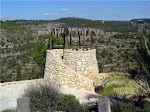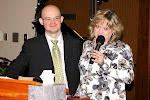Early in the month of March, I had decided to request off of work for Passover eve/day (April 15/16). During holy week, I had asked the Lord what He would have me to do – go to a seder (Jewish Passover meal), go out of town, host a Passover meal with my family, etc. I never felt a direct leading of the Spirit of the Lord, and have been wanting to go camping. I decided on Wednesday that that's probably what I would do. I talked with my sister who lives on a large rural property north of Indianapolis and she agreed that would be fine. So, on Friday, I headed up north, stopping on the way to get basic supplies for a small seder to commemorate the Lord's supper. It was a beautiful afternoon and I got my camp set up and shared in a small communion with my sister. I went to bed around 9pm and was awakened by a coyote pack yipping and barking in the close vicinity. I would have recorded it, except I fell back asleep to quickly because it was raining hard outside my tent.
I was awakened on Saturday morning by a variety of song birds chirping loudly in the woods. I could also distinguish about 3 or four different doves cooing to one another. After I got up and dressed, I decided to walk around the large field. When I was approaching the back corner where there is a small wooded area with tall grasses, suddenly two animals sprang to their feet and ran away from me into another nearby field. Just as they were clearing the trees, I realized it was two small coyotes, that had bedded down for the morning. It was only about a quarter of a mile from my campsite. While most people would have been alarmed, I felt God's presence and hand even in this.
When I arrived back to my campsite, I felt compelled to read the Song of Solomon. There is a verse that talks about the rain being over and the birds singing in the trees, also the voice of the dove being heard – so much of the experiences I had had that morning. The Jewish sages teach that the Song of Solomon is an allegory about the Israelites journey out of Egypt and through the wilderness. As a believer in the Jewish Messiah, Yeshua (Jesus), I believe it is an allegory between the Bridegroom (Yeshua) and His Bride.
After packing up my camp late in the evening, while driving back home, I glanced over to see a doe standing beside a small creek that runs beside the road. I began to weep thinking about the references to the deer in the Song of Solomon. Then I was reminded of the psalm of David, “As the deer pants for the water brooks, so pants my soul after You, O God.” Psalm 42:1
The next morning, after praying, I read from my devotional that I have used for many years, now – Daily Light on the Daily Path. This is a morning and evening devotion that is simply Scriptures placed together by believers from 18th century – Jonathan and Samuel Bagster. So oftentimes, the Lord has spoken directly to my situation and given me direction through this book. The morning devotion was certainly good, but I found my eyes looking down to the evening section. The headline read “Draw me, we will run after thee,” which is a line from SOS 1:4. I was ecstatic, but I decided not to get ahead of myself by reading the evening portion.
After work, on Sunday, I came home and
watched the Sunday morning service of a church. The pastor was
speaking from Song of Solomon 2:11-12, “For lo, the winter is
passed, the rain is over and gone; the flowers appear on the earth;
the time of the singing of birds is come, and the voice of the dove
is heard in our land.” I could not wait until my evening prayer
time. I opened my devotions and read the rest of my evening portion.
THERE it was: Song of Solomon 2:10-13! I almost passed out in the
floor from excitement. It was as if the Great Shepherd was showing
Himself through the lattice. He was speaking to me over and over:
“Arise my love, my fair one and come away!” SOS 2:10
I am sure there is much more He will unfold to me concerning this past weekend with Him, but I am so thankful for the glimpses that He gives us of His face.






